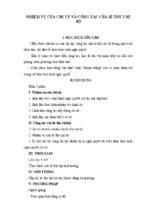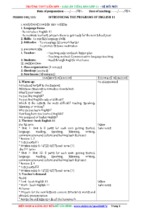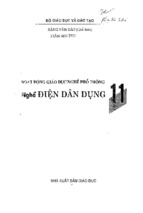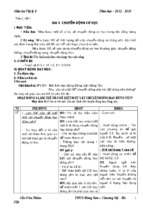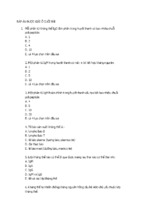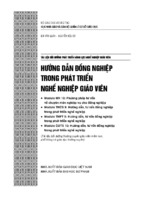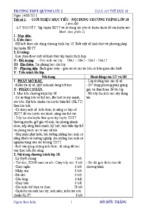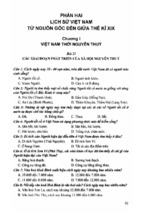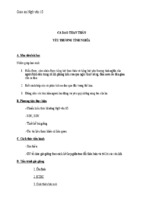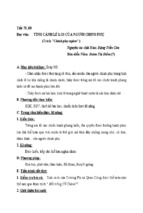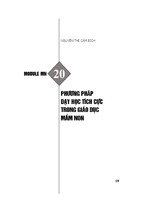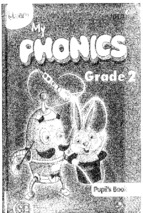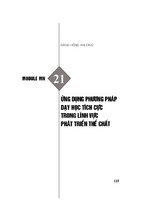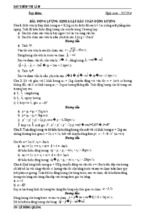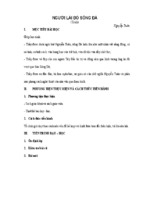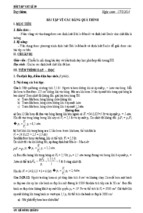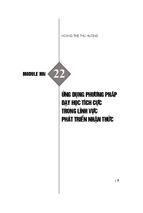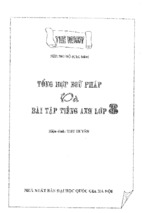phßng gi¸o dôc bØm s¬n
trêng t.h.c.s xi m¨ng
Gi¸o ¸n
Bé m«n: TiÕng Anh
Khèi:
8
Tæ: tæng hîp
Gi¸o viªn: nguyÔn v¨n s¸ng
n¨m häc: 200 - 200
N¨m friends
häc: 2006 - 2007
Unit 1: My
Period No 2: Getting started & listen and read.
Teaching date:
.200.
I. Objectives:
- Ss will be able to use present tense more fluently
- Understand and use some model sentences clearly, exactly.
II. Language content:
Vocabulary: Seem
Structure: What do/ does ...........look like?
To seem + adj + comp.
To be (not) adj + enough
III. Teaching method:
IV. Teaching aids: Textbook, teacher's book, pictures
V. Time: 45'
VI. Steps of teaching.
1. Getting started - (warm-up)
Sports
- Ask students more questions: Which sports do you like?
- Ask students to use the "network" to practice in pairs
2. Listen and read:
- Ask students some questions such as:
+ Do you know where the picture is?
+ Who are they in this picture?
+ Where is Hoa from?
- Ask students to tick T/F.
a. Hoa's friend's name is Nien.
b. Nien is from Thanh Hoa.
c. Nien is thirteen years old.
d. Nien is not beautiful.
e. Nien is going to visit Hoa on summer vacation.
- Ask students to listen the dialogue twice then read in pairs.
(T: correct mistakes).
- Ask students to find the model sentences: What do/ does + s + look like?
(Teacher explain)
: to seem + adj + comp....
: to be (not) adj enough + to + V.ing
- Then give some adjective word for Ss to make new sentence...
- Ask Ss to practise the model sentences by using given words.
- Ask Ss to ask and answer the questions in pairs then call some pairs to find out in
front of class. (teacher give the right answers)
3. Production:
Ask a student to go to the board to write sentence by using model sentences.
4. Homework:
Unit 1: My friends
Period No 3 + 4: Speak and Listen.
Teaching date:05/9/2006..
I. Objectives:
- Ss will be able to describe the apperance and characters of each person.
- Develop the listening skill.
- Introducing people and responding to introducing
- Listening to fill in the gap.
II. Teaching method:
III. Teaching aids: Textbook, tape, cassette
IV. Time:
V. Steps:
1. Presentation:
* New words: Curly ( picture) fair
( explain)
slim ( picture)
Bold
straight
blond
2. Read the dialogue:
- Ask Ss to answer about others in class.
What do/ does + S + look like?
- Draw some pictures
- Ask Ss to guess the person in class by the description of teacher. Then do the same
in pairs
- Ask Ss to look at the pictures and speak out the apperance and character in book.
* Practice:
- Remind the students of grammar notes: Tobe + adj ......;to
to have + a/ an + adj + N.
- Ask Ss to describe one of their partners and ask others to guess who he/she is.
* Production:
Describe more about the VIP in Vietnam.
Eg: He's a simple man, he has long beard and bright big eyes. Every one in Vietnam
and in the world know him. Who's he?
3. While - listening:
- Ask Ss to look at the book and listen.
- Ask Ss to listen the dialogue again and fill what they hear in the blank.
- Then ask each group to read completed dialogues.
- Gets the groups to compare the dialogue with their production
- Correct the mistakes and then ask Ss to listen once more.
4. Post-listening:
- Ask Ss to work in pairs.
- Ask some pairs to practice the dialogue.
- Teacher gives new situation and ask some Ss to make up new dialogues.
5. Consolidation:
- Ask Ss to write then read about a close friend or draw some one by listen to
teacher's description.
6. Homework.
Unit 1: My friends
Period No 5: Read.
Teaching
/200.
I. Objectives:
- Ss will be able to understand how to describe the character, appearance,
hobbies of friends.
II. Teaching procedure:
A. Warm up:
Devides class into 2 groups and describe some one they like missed/ lived
B. Pre-teach:
1. Vocabulary:
+ Character (n) (explain)
+ out going (a)
+ Sociable (a)
+ volunteer (a)
explain
+ generous (a)
translation
+ resewed (a)
- T/F prediction:
There are people in this passage.
Khai dislikes school.
Ba's friends never annoy each other
Bao is the most sociable.
2. While - Reading:
- Ask Ss to read the text and check their prediction.
- Correct their prediction.
- Teacher corrects.
- Read the text carefully and choose the best answer the qs.
3. Post - Reading:
- Ask Ss to talk about their close friends.
- Chain gaine.
4. Homework:
- Write E in the notebook.
- Prepare next lesson.
- Learn by heart vocabulary.
.....................................................................................................................
Unit 1: My friends
Period No 6: Write.
Teaching date: 10/9/2006.
I. Objectives:
- At the end of the lesson, Ss will be able to. Write a short paragraph about
their friend improve the skill of writing.
II. Teaching method:
III. Teaching aids: Textbook.
IV. Time: 45'
V. Steps of teaching.
1. Pre - writing (warm-up)
- Give a picture and ask Ss to describe.
- Ask some Qs about the information about personality.
2. While:
- Ask Ss to ask and answer about Tam.
What's his name?
How old is he?
Where does he live?
- Ask Ss to do the some ( about Ss in class)
- Ask Ss to use part 2 to write a passage.
- Ask some to road out ( T corrects mistakes)
- Ask Ss to write about the person you like best.
- Ask Ss to wirte a passage about their partner.
3. Consolidation:
Ask Ss to complete sentences using word/cues.
a. Mai/my friend.
b. She/13
c. She / on TranPhu street with her parents.
d. She/ beautiful/ and/ short hair/ black eyes.
e. Binh/ Bach/ her best friends.
4. Homework:
- Give information about your self.
- Prepare next lesson.
........................................................................................................................
Unit 1: My friends
Period No 7: Language focus
Teaching date: 18/9/2006.
I. Objectives:
- Ss will be able to:
+ Use the simple present tense and the past tense effectively
+ Use structure: (Not) adj + enough + to -infinitive
in communication.
II. Teaching method: Communicative approach.
(individual/ group)
III. Teaching aids: Textbook, extra board, picture
IV. Steps.
1. Warm - up:
- Divide class into 2 groups A-B
GA: Write sentences in the present tense
GB: Change into the past tense
2. New lesson:
2.1+2: Complete the passage. Then the correct form of the verbs.
- Ask Ss to repeat the form of present and past tense. Then do exercises.
- Ask Ss to read after finishing (one by one or in pairs)
- Give some wrong sentences then ask Ss to correect.
2.3: Hang on a picture and ask Ss to practice: asking and answering
- Ask and answer the qs about member in class.
- Ask Ss to answer the qs about people in text book's picture.
* Use: (Not) adj + enough + to + V (infi) to complete.
- Ask Ss to make up sentences, using word cues.
Eg: 1. Ba / intelligent/ this test.
2. This film/ not intereting/ to see.
- Ask Ss to read in silence the sentences provided then do exercise.
- Ask Ss to give the structure again.
3. Production:
- Ask Ss to play cross word: find verbs pf past tense and present.
- Play game: GA: gives a verb ( in past tense or present)
GB: makes up sentences (change the job)
< Each right sentence gets 2 marks>
V. Homework:
- Write part 4 in the notebook.
- Prepare next lesson.
.....................................................................................................................
Unit 2: Making arrangements
Period No 8: Getting started & listen and read.
Teaching dat: 18/9/2006.
I. Objectives:
- After learning, Ss will be able to talk about intentions with "be going to", use
the telephone to make and confirm arrangements, take a telephone message.
II. Preparation:
a. Teaching methods: Communitive....
b. Teaching aids: Textbook, cassette, picture, poster.
c. Time: 45 minutes.
III. Steps of teaching:
1. Getting started ( warm-up)
T: Gives the pictures in the textbook and asks "what is this".
Ss: Answer the questions in Vietnamese.
T: - Gives some posters and asks S to match them with the pictures.
- Asks Ss to listen and repeat the words in poster.
2. Presentation:
* Listen and read:
- Look at the pictures and guess. What they are telling.
- Listen the tape twice to go topic of the text.
* Ss practice the dialogue in pairs:
- Some pairs read out begin class ( correct S's mistakes)
- Corrects guessing and prounciation
Note:
- Hold on
Techiques: - Synonym . wait some minutes
- Where is it on?
: - Translation
- I'm using my cousin's bike tonight. (future with "be going to")
- I'm going to see the movie Dream City at 6.45
- Ss answer the qs (a-f) by playing game "lucky number".Then "survey" Nga made
the call she.
* Gives "open dialogue" (with other situation)
- To ask Ss to practice in pairs.
IV. Home work:
- Practise the dialogue again.
- Ask Ss to write the correct answer at home.
- Prepare some sentences with "be going to" and new lesson.
....................................................................................................................
Unit 2: Making arrangements
Period No 9 + 10: Speak and listen.
Teaching date: 20/9/2006.
I. Objectives:
- After the lesson, Ss can be able to practice speaking and listening about
using the telephone to make and confirm arrangements.
II. Preparation:
1. Ways of working: Pairs, groups, individuals.
2. Teaching aids: Textbook, some posters, tape, cassette ....
3. Time: 45 minutes
III. Procedures:
1. Pre-speaking:
* Revision:
- Ask Ss to read the dialogue by heart.
+ Gives some Qs about the content of dialogue.
Ex: - Is Hoa going to see the movie Dream City at 6.45?
- Who arranged a meeting place? .....
(Eliciting)
2. While-speaking:
T: Introduces about picture in part 2.
Asks some Qs: Who made call?
Who invited the other to play chess?
T: - Gets Ss in pairs and fill the blank in open-dialogue.
- Gets the groups to compare the dialogue with their prediction.
- Correct mistakes then asks Ss to practice the open-dialogue.
(in pairs)
- Ask Ss to look at part 1 and give situation.
- Divides the class into 4 group and discuss to complete the conversation.
- Each group puts the sentences the correct order on the board.
T: - Corrects mistakes
- Ask Ss to practise it again.
3. Pre-Listening:
- Sets the science.
- Hangs the poster and read whe information to fill in blank.
4. While - Listening:
- Gets Ss to look at the book and listen to whole dialogue for the first time.
- Gets Ss listen to the dialogue again and fill what they hear in the blank.
- Gets Ss listen once more to check the information they get.
- Gets a pair to read their complete the missing information.
- Gets other to give theirs opinions.
- Gets the group to compare the dialogue with their prediction.
- Corrects the mistakes.
5. Post-listening and speaking:
- Play game "lucky number" about part 1, 2, 3.
* Questions:
1. Who is going to a pop concert at the City Concert Center?
2. Lucky number.
3. What time can Eric and Adam meet?
4. Who can play chess tonight?
5. Lucky number.
6. What is Ba going to do tonight?
7. Lucky number.
IV. Homework:
.................................................................................................................
Unit 2: Making arrangements
Period No 11: Read.
Teaching date: 25/9/2006.
I. Objectives:
- By the end of the lesson.
+ Ss will be able to develop reading skill they can understand about
Alexander Graham Bell by them of the lesson.
II. Teaching produres:
A. Warm up:
- Ask Ss to talk about the importance of the telephone.
- Use the picture in textbook to introduce Alenxander Graham Bell who
ivented the telephone.
B. Pre-Reading:
* Pre-teach:
- T: Read once time.
- Ask Ss to find the new words and them T write on the board
Explaination: Emigrate (v).
Deaf - mute (n).
Experiment with (v).
Transmit (v).
Conduct (v).
Assistant (n).
- Ask Ss to check the boxes T or F by predicting.
C. While - Reading.
- Ask Ss to read the passage in silence and check their prediction.
- Correct their prediction and correct the false sentences.
- T corrects last once.
- Ask Ss to read the passage alound and correct their pronunciation.
- Ask Ss to put the events in the correct order (work in pair).
- Ask some Ss to answer.
- Give correct order and explain structure "Neither...nor..."
D. Port - Reading:
- Ask Ss to tell about Alexander Graham Bell wkthout textbook.
- Ask Ss to practise the structure "Neither....nor...".
E. Homework.
- Ask Ss to learn by heart vocabulary.
- Ask Ss to write a short passage about a scientist that they know.
- Ask Ss to prepare new lesson.
.................................................................................................................
Unit 2: Making arrangements
Period No 12:
Write.
Teaching date: 25/9/2006.
I. Objectives:
- By the end of the lesson, Ss will be able to develope writing skill about
talking a telephone message.
II. Content:
* Grammar:
- Intention with " be going to".
- Adverbs of place .
* Vocabulary.
III. Teaching aids: tape, cassette, some posters.
IV. Steps of teaching:
1. Warm up:
- Gives some pictures and asks Ss to predict the content of picture.
2. Pre-writing:
- Gives some pictures and posters to help Ss to understand the content of that text.
- Ss read a poster "Thang Loi Devivery Service" and find some informations to fill in
to the blank.
- Corrects mistakes and then asks Ss to read it
3. While- writing:
- Devices the class into 4 groups and gives some posters.
- Asks Ss to read the text ( in silence)
- Gives some new words: stationary -> order -> expaination.
- Asks Ss to complete in the posters.
- Gets Ss to compare each other.
- Asks 4 Ss in each group to write on the board.
- Corrects mistakes.
4. Post - Writing:
- Gives a poster and Ss to read part 3.
- Complete informations in the poster.
V. Homework:
- Gives a passage and asks Ss to complete in the posters of massage.
- Asks Ss to prepare language focus.
.......................................................................................................................
Unit 2: Making arrangements
I. Objectives:
Period No 13:
Language focus
Teaching date: 01/10/2006.
- To review the way of talking about intention with "be going to"
- The use of adverbs of place: Out side, here. ......
II. Content:
- Future with "be going to"
- Adverbs of place.
III. Methods:
- Communitive and other suitable methods.
- Techniques: Ask and answer.
Noughts and crosses...
Gap fill....
IV. Teaching aids: posters, book, pictures...
V. Time: 45 minutes.
VI. Procedure:
1. Warm up:
- Asks Ss to match the verbs of simple tense with the verbs of simple past tense:
Buy
Had
Give
Liked
Have/has
Bought
Like
Gave
Invite
Was/were
Be
invited
(Eliciting)
2. New lesson - Language focus:
2.1. Say what the people......... sentence.
- Give an extra board with "noughts and crosses"
- T. models: Nga has a movie ticket.
-> She's going to see a movie.
Note: "Be going to"
- Play the game "Noughts and crosses".
2.2.
- Give the "grid".
What are you going to do on the weekend?
Are you going to do ...
You
Your partner
See a movie?
Play sports?
Meet your friends?
- Gets questions: "Are you going to...?"
- Gets Ss to answer and tick into "you" column in grid.
Eg: Are you going to see a movie?
Yes, / No, I am.
- Asks Ss to work in pair ( Ask and answers each other).
Ticks the answers in "your partner" column.
- Then gets Ss to practice:
2.3. Complete the............. box once:
- Play "Network":
outside
Adverbs of place
- Introduces the situation: Ba is playing hide.....
- Gives six pictures in the textbook and asks.
T: Where's Tuan?
S: I think he is........
- Gives yes/no questions:
Eg: Is he upstairs?
Yes/No...
- Corrects mistakes.
3. Production:
- Gives some statements and Ss tick T or F.
(Using statements in Ex3 - P.26)
4. Homework:
- Asks Ss to write 10 sentences with "be going to" from the grid in box
- Learn by heart the structure "be going to" and adverbs of place.
- Prepare new lesson.
............................................................................................................
Unit 3: At home
Period No 14: Getting started & listen and read.
Teaching date: 01/10/2006.
I. Objectives:
- Say where the things are.
- Use the modal verbs to advise.
II. Content:
- Reflexive pronouns
- Review modal verbs: "Have to" and "ought to"
III. Method: Communicative approach.
IV. Teaching aids: Teacher's book, picture .....
V. Teaching steps:
1. Warm-up: (getting started)
- Ask Ss some Qs about their house work.
- Ask Ss to look at the pictures and descibe.
(Introduce some new words such as: tidy up; sweep)
2. Listen and read. (Presentation)
* Set the scene: Give the situation of the dialogue.
* Pre teach: + Review the usage of modal: "ought to" and "have to"
+ Introduce some new words:
- Yourself (pro) -> situation
- Cupboard (n) -> explaination
- Steamer (n) -> explaination or picture
- Saucepan (n) -> picture.
- Play the tape twice
- Let Ss read in pairs
- Have them practice the dialogue. Correct their mistakes
- Play "Rub out and Remember" the word have been introduced.
* Practice:
- Divide the class into 4 groups to list what Nam has to do.
- Key of each group is given by its leader and get other remark.
* Feed back: Ask Yes-No questions.
* Production: Ask Ss to write 4 sentences using "ought to", "have to".
- Play chain game with "ought to" and "have to"
3. Homework:
- Being a student and a child/ Write what you "have to" and "ought to" do.
- Learn by heart the new words.
- Prepare speaking.
.........................................................................................................
Unit 3: At home
Period No 15:
Speak.
Teaching date: 01/10/2006.
I. Objectives:
- Say where the furniture is put
- Review the prepositions of place.
II. Teaching aids: Big pictures
III. Method: Individual and pairs
IV. Teaching steps:
1. Warm-up: Divide the class into 2 parts and play networks with items.
clock
Things
Thhhin the kitchen
- Hang the 1st picture and ask Ss to call some name of the things in it.
- Let Ss work in pairs with model sentenses.
A: Where + be + N ?
B: It's/ They're + prepositions + place.
(While review the preposition of place)
- Teacher correct Ss' mistakes.
2. Practice: Review the structure with: + Let's .....
+ Yes, let's ..../ Ok
+ No. I think you should/ ought to / had better
- Hang the second picture and say its requirement.
- Divide the class into 4 groups and ask each group to arrange the things in the
picture in their opinion (encourage them to draw)
- Call the leader of each group to say their arrangement.
- Teacher asks others to remark and correct mistakes.
3. Production:
- Ask some students to talk about the place of the things in their kitchen/ livingroom/ classroom.
- Ask others to remark or give opinion about the situated.
4. Homework:
- Remember the things around the house and pre-of place.
- Talk fluently about the situated of their own things.
.........................................................................................................
Unit 3: At home
Period No 16:
Listen.
Teaching date:08/10/2006.
I. Objectives:
- Practise listening skill
- Find out the correct informations of Chinese fried rice.
II. Content:
III. Teaching aids: Text book, picture, cassette ....
IV. Teaching steps:
1. Pre - Listening:
Set the scene by playing the network:
Vietnamese fried
rice ingrediance
- Hang the picture and ask students to look at it.
- Say the content of the listening.
- Divide the class into 4 groups and let them predict what are used to make Chinese
fried rice.
- T collects their predictions or asks students to write their predictions.
2. While - Listening:
- Let them listen twice.
- Ask students to compare their answers.
- Call some students to write their answers and get others to remark.
- Play the tape and give the correct answer.
3. Post- Listening:
Ask students to give the steps of marking simple dishes and ask others to guess the
names of the dishes.
4. Homework:
- Write the steps of making your favorite dish.
- Prepare "reading".
...........................................................................................................
Unit 3: At home
Period No 17:
Read.
Teaching date: 08/10/2006.
I. Objectives:
- By the end of the lesson.
+ Ss will be able to understand the Safety Precautions in the time.
II. Teaching produres:
A. Warm up:
gas
- Brain stormimg:
boilingwater
fire
Danger in the
electricity
home for
children
knife
B. Pre-Reading:
1. Pre-teach vocabulary:
- Ask Ss to find the new words, then T write on the board
+ a precaution: (explanation)
+ (to) injure: (visual)
+ a socket:
(realia)
+ a scissor
(realia)
+ an object
2. True/ False prediction: (poster) (close students' book)
Answer: (page 31)
- Ask Ss to predict: True or False
C. While - Reading.
- Ask Ss to read the text and check their prediction.
- Correct their prediction each other.
- Teacher corrects last once.
- Ask Ss to read the text alound and correct their pronunciation.
- Read the text carefully and answer the questions.
Why - question (Ex 2: answer the question)
- Ss work in pairs
- Play lucky number to check their answers.
D. Post - Reading: Discussion/ word cues drill
- Work in groups (check before class ...)
- Speaking something about safety precautions in the home.
- Ask Ss to practise the structure " Why must ... ?, why mustn't .... ?"
E. Homework.
- Ask Ss to learn by heart vocabulary.
- Make sentences with them
- Write some safety precautions in the home (5 lines)
- Ask Ss to prepare new lesson.
.............................................................................................................
Unit 3: At home
Period No 18:
Write.
Teaching date: 08/10/2006.
I. Objectives:
- Students will be able to describe the room, kitchen, class base on given
words, pictures.
II. Teaching aids: Pictures, text book.
III. The content of language:
1. Grammar: + There is/ are ....
+ Some preposition of place such as: On, in, at......
2. Vocabulary: + Disk rack, lighting fixture, towel rack.
IV. Procedure:
1. Warm-up:
- Ask Ss to make sentences with "there is", "there are","preposition of place" to
describe things in their classroom.
2. Pre-Writing:
- Hang the first picture and ask Ss to describe Hoa's bedroom.
- Ask Ss to read the description of Hoa's room in the text book.
3. While - Writing:
- Guide Ss the request of writing lesson 2 on page 33.
- Hang the second picture and ask Ss to write a description of Hoa's kitchen.
- Ask Ss to work in pairs by checking each other.
- Ask 2 Ss to write their writing.
- Ask some Ss to correct the mistakes.
- Teacher gives the correct answer.
4. Post - Writing:
- Hang the third picture and ask Ss to describe things in this picture.
5. Homework:
- Ask Ss to write a description of a room in their house.
- Do exercises in your exrcise book.
- Prepare language focus (page 34, 35).
...................................................................................................................
Unit 3: At home
Period No 19: Language focus
Teaching date: 15/10/2006.
I. Objectives:
- To review the way of talking about the reflexive pronouns
- The use of modals: must, have to, ought to.
- Why - because
II. Content:
- the Reflexive pronouns
- Modals: must, have to, ought to.
- Why - because
III. Methods:
- Communitive and other suitable methods.
- Techniques: Ask and answer.
Noughts and crosses...
Gap fill....
IV. Teaching aids: Posters, book, pictures...
V. Time: 45 minutes.
VI. Procedure:
1. Warm up:
- Asks Ss to remind personal pronouns and possessive adjective:
I
--> my
You -->your
He --> his
She --> her
It --> its
We --> our
They --> their
2. New lesson - Language focus:
2.1. Look at the pictures. Complete the dialogue. Use must or have to and the verbs
in the box.
- Ask Ss to read the dialogue in silence - do exercises
- Ask Ss to remember the structures in grammar
S + must + V......
- After finished exercise 1 T " check again"
Ex: You must go to school on time.
- Ask Ss to correct
2.2. Look at the pictures. Use ought to to give advice to these people.
- T "set the sentence" Ex 2 by play game "guess word"
O U G H T T O
- Ask Ss look at the picture and do exercise
- Ask Ss to remember the structures in grammar
S + ought to + V
- T can "check agian" Ex 2
2.3. Complete the dialogues. Use the reflexive pronouns in the box.You will have to
use some of the reflexive pronouns more than once:
- Ask Ss complete the dialogues. Use the reflexive pronouns in the box
- Correct the mistakes if necessary.
2.4. Work with a partner. Ask and answer questions about Hoa, Nam, Nga and Mrs.
Vui using Why - because.
3. Production:
4. Homework:
- Asks Ss to write 10 sentences use the "reflexive pronouns"
- Learn by heart the structure "why - because".
- Prepare new lesson.
..................................................................................................................
Period No 20: revision and written test
Teaching date:15/10/2006.
I. Consolidation:
+ Use the simple present tense and the past tense effectively
+ Use structure: (Not) adj + enough + to –infinitive
+ To review the way of talking about intention with "be going to"
+ The use of adverbs of place: Out side, here. ......
+ the Reflexive pronouns
+ Modals: must, have to, ought to.
+ Why – because
II. Written Test 45':
C©u I. Chän d¹ng ®óng cña ®éng tõ trong ngoÆc: (2.5 marks)
1. We (visit) ............... our grandparents last weekend.
2. Nobody (like) …………… him because he is lazy…
3. He (study) ……………….. French next school year.
4. Mai (have) ………………. to do assignment tomorrow.
5. They (play) ……………… soccer now.
C©u II. ChuyÓn nh÷ng c©u sau sang d¹ng phñ ®Þnh vµ nghi vÊn: (2.5 marks)
1. She has to do her homework now.
-> (-) ………………………………………………………….
-> (-) ………………………………………………………….
2. They went to Ha Long Bay last summer.
-> (-) ………………………………………………………….
-> (-) ………………………………………………………….
3. He was here last Sunday.
-> (-) ………………………………………………………….
-> (-) ………………………………………………………….
4. You must do this work now.
-> (-) ………………………………………………………….
-> (-) ………………………………………………………….
5. Mr. Ba will have a new job next month.
-> (-) ………………………………………………………….
-> (-) ………………………………………………………….
C©u III. §iÒn mét tõ cßn thiÕu vµo c¸c c©u sau: (2.5 marks)
1. What ……………… you going to do tonight?
2. …………………. are they like? They are good looking.
3. …………………do you go to school every day?
4. He ……………..short, black hair.
5. What ……………you do last night?
C©u IV. §äc ®o¹n v¨n. TÝch ®óng (T) hoÆc sai (F) Vµo c¸c c©u sau: (2.0 marks)
Lan and I went camping last week. We had alot of fun. The weather was cool
and windy. We spent the most time walking up the hill cooked a very good meal
with food we bought in the morning. At the top of hill we came back home at 5 p.m.
Tick: 1. Lan and I went camping lats year.
2. We spent most the time eating and drinking.
3. We came back home at 5 p.m.
4. The weather was cool and windy.
Unit 4: our past
Period No 21: Getting started & listen and read.
Teaching date:15/10/2006.
I. Objectives:
- After learning, Ss will be able to talk about event in the past.
- Understand the fact or opinion.
II. Preparation:
a. Teaching methods: Communitive....
skill: - Ask and answer the questions
- Listen and repeat
- Play game "Noughts" and " Crosses"
- Work in pairs
b. Teaching aids: Textbook, teacher's book, workbook, cassette, picture.
c. Time: 45 minutes.
III. Steps of teaching:
A. Getting started ( warm-up)
- Suggest for 4 groups to practise.
- Call 4 Ss on behalf of 4 groups go to the board and write the names of the
things that do not belong to the past.
B. Presentation.
* Listen and read.
- Introduce the dialogue "Nga's grandma is telling to Nga about Nga's greatgrandma and what the great-grandma did"
- Listen the tape oce or twice.
* Pre teach.
- Introduce new words:
+ Look after (v) = take care of (syn)
+ Equipment (n) Eg: diskwash, washing machine, sewing machine ....are
equipments.
+ Great-grandma. Question: "what do you call your grandma's mother?"
+ Folktale. Eg: "TÊm C¸m" is a folktale.
- Check: Rub out and remember.
- Ss listen and read in chorus, to practise pronunciation and intonation.
C. Practice.
1. Practice the dialogue with a partner.
- Ask Ss to practise in pairs.
- Correct the mistakes of pronunciation and intonation.
2. Work with a partner. Ask and answer the questions
- T to explain about exercises
- Ask Ss work in pairs.
- Check: call one pair ask and answer.
- Use the structures: + what .... like?
+ used to ......
+ had to ......
Fact or opinion? Check (V) the boxes.
- T to explain "fact" or "opinion"
-Add 3 sentences g, h, i to play game "Nought and Crosses"
D. Production.
- Each student says 3 -> 5 sentences about habits in the past but do not now
(uesd to).
E. Homework.
- Write 5 sentences talk about habits in the past.
- Copy the answers in exercise 2
- Write 5 sentences about "fact" and 5 sentences about "opinion"
- Prepare new lesson.
..................................................................................................................
Unit 4: our past
I. Objectives:
Period No 22:
Speak.
Teaching date: 22/10/2006.
- By the end of this lesson, Ss will be able to improve their speaking skill by
talking about life in Vietnam in the past and at present and using “used to”
II. Content: “ + used to”
“ had to ”
“ past simple tense”
III. Materials: - Pictures
- Posters
IV. Methods: - Communicative
- Pair work, group work.
V. Procedure:
1. Pre-speaking:
a. - Use guessing game.
b. - Look at pictures, make the list of things you can see
Picture 1:
- Small houses, cottage
- Stack of straw
- Traditional clothes
- Children often play square game at home.
- People work on paddy field.
- There isn’t any elictricity.
- Children don’t go to school.
- People raise cattle.
- The work sounds hard.
Picture 2:
- Modern supermarkets, shops.
- Moden clothes.
- Mobile phone.
- People travel by car, motorbike, bike.
- Children go to school.
- People live in big houses, high buildings.
- There are lot of time for entertainment.
things.
- Life is more interesting, exciting, comfortd.
- There in electricity every where.
- People cook with gas…
2.While-speaking:
- Work in groups.
- Talk about difference between life in the past and now by using “used to”.
Ex: -There didn’t use to be electricity.
- There is electricity every where.
- People used to live in a small house or cottage but now they live in a big
house or high building.
- Children used to play traditional games such as square game, blind man’s
bluff, Dragon and snak game, marbles, skip…
- Now they play modern games like computer games.
- Children didn’t use to go to school, they used to stay at home and do the
chores now they go to school and do what they like.
- People used to travel on foot but now they go by car, motorbike or bike.
- There didn’t use to be new on modern clothes and shoes.
- Now there are many skirts, long dresses, European clothes and shoes.
- Life used to be very hard and miserable.
- Now life is more and more comfortable and there is a lot of entertainment.
……………………..
- Each group will peak aloud their topic.
- Check their mistakes or give them assistant if they need.
3.Post-speaking:
- Work in pairs.
- Tell your partner about things you used to do last year.
Last year
Now
I used to get up late.
I get up early.
I used to play soccer.
I play video games.
I used to play skip.
I play chess.
I used to go school on foot
I go to school by bike.
I didn’t help my mom with housework.
I help my mom a lot.
4. Consolidation:
- Used to do refers to something that you regularly did in the past but don’t do
any more.
- Be/get used to + V-ing refers to something that you get familiar with/get
accustomed to doing something.
Ex: I am used to getting up early.
I am used to driving on the left.
He gets used to having a bath in the morning.
5.Homework:
- Write a paragraph to tell about what you often did in the past using“used to”.
- Write 5 sentences to tell about what you got familiar with.
- Do exercises in book.
Unit 4: our past
Period No 23:
Listen.
Teaching date: 22/10/2006.
I. Objectives:
- By the end of the lesson, Ss will be able to improve their listening skill by
listening to the story moreover, students will learn a moral lesson to live better more
useful.
II. Materials: textbook, the stereo, the tape.
III. Methods
- Communicative…
- Pair work, group work.
IV.Procedure:
1.Pre-listening: work in group.
- Play chain game.
Ex: S1: I used to live in the mountainous area.
S2: I used to live in the mountainous area and I used to play square game.
S3: S1 - S2 and I used to get up late.
Sa:………………
2.While-listening:
* Pre-teach vocabulary: moral lesson (traslation)
- Foolish >< clever
- Greedy (Ex: he is very greedy)
- Gold (traslation)
- Let them listen to the story twice.
- Ask them to write the letter of the most suitable moral lesson.
- Correct answer: Don’t be foolish and greedy.
- Let them listen to the tape once more to check the ansswer.
3.Post-listening:
- Use transformation speaking.
- Play ordering vocabulary:
Earn
Hard
Stays
Teacher
Happier
Travel
Work
My family used to live in the mountainous area, but now we live in the
country side. My father used to work in Hanoi. He used to earn a lot of money but
now he stays at home and help my Mom. My mother used to a teacher, she used to
be a good teacher she said life used to be very hard, but now we life in more
comfortable and happier.
4.Homework:
- Do exercises in the book.
- Practice speaking the story.
- Prepare new lesson
Unit 4: our past
Period No 24:
Read.
Teaching date: 22/10/2006.
I. Objectives:
- By the and of the lesson, Ss will be able to improve their raeding skill and
their vocabulary by reading “The lost shoes” story. Moreover they can learn a moral
lesson from the story.
II. Materials:
- Posters, pictures, the text book, T and Ss’ book.
III. Methods:
- Communicative
- Pair, group work.
IV. Procedure:
1.Pre-reading:
+ Use pre-questions:
- What do you often do in your free time?
- Do you often read stories?
- What kinds of stories do you often read?
like?
-Have you ever read or heard “Tam Cam”
+ Use ordering statements.
- Work in groups.
-Pre teach vocabulary:
- Married
- Get maried with Sb.
- Unfortunately = unluckily.
- Cruel >< kind.
- Upset = happy, die of: chÕt v×, do
- Broken heart.
- Held (hold) = organize.
- Harvest (n): when farmers cut rice.
- Festival: (Ex:Hue festival)
- Excited: h¸o høc, n¸o nhiÖt.
- Prince: king’s son; princess: king’s daughter.
- Had none: had nothing.
- Fairy (n): bµ tiªn,
- Magically (translation).
- Rags: very old ugly clothes.
- Own = have, belong to.
- Fitted (v): võa vÆn
- Immediately = at once (adv)
- Fell in love with Sb: love Sb a lot.
- Change sth into sth: biÕn c¸i g× thµnh c¸i g×.
2. While-reading:
- Let them read softly or whisperedly.
- Then ask them to complete the sentences from the story.
- Ask them to practice in pairs to ask and answers questions in book.
- T gives them a help if they need.
- Check and correct.
3. Post-reading:
- Use transformation speaking technique.
- Read aloud and translate story.
...............................................................................................
Unit 4: our past
Period No 25:
Write.
Teaching date:29/10/2006.
I. Objectives:
- By the end of the lesson, students will be able to improve their writing a
story moreover they can learn more words used correctly and complete, perfect the
past simple tense.
II. Contents: - past simple tense.
- Prepositions of place.
III. Materials: - Pictures, poster.
- Text book, T and Ss’ book.
IV. Methods: - Comunicative …
- Pair and group work.
V. Procedures:
1. Pe-writing:
- Use pre-questions.
+ Do you like reading stories?
+ Do you remember any of them?
+ Do you know why the tiger have black stripes?
+ Which story tell you about that?
+ Who is the main character in this story?
- Pre-teach: Vocabulary:
burn (v) Ex: you light the candle and it burns.
escape (v) Ex: the criminal often escape from the prison if we aren’t careful
grazed (v) the buffalo usually grazes grass
tiger (n): (picture)
a rope (visual)
servant (n) visual
straw (visual)
master (n) visual
black stripes (n)
wisdom = intelligence.
2. While-writing:
- Look at the book, read the story using the words in the box.
- Work in individual
- Compare with your partner.
- Ask them to read aloud
- Check and correct.
Keys: 1: appeared
5: went
2: was
6: tied
3: said
7: lit
4: left
8: burned
9: escaped
3. Post-writing:
- Do exercise 2 in book
- Use transformation writing
he -> I
or the tiger -> I
- Ask them to write the story and read aloud.
- Check and correct
+ Then ask them to roleplay the tiger and the man.
4. Homework:
- Learn by heart new words.
- Rewrite the story.
- Retell it.
- Prepare “language focus”
- Do exercise in exercise book.
..................................................................................................................
Unit 4: our past
Period No 26: Language focus + Correct the test
Teaching date: 29/10/2006.
I. Objectives: - By the end of the lesson, Ss will be able to consolidate the past
simple tense, “used to” and prepositions of time. Moreover they can improve their
knowledge by doing some exercises in book and in reference books.
II. Materials: - Pictures, posters, text book, reference book.
III. Content: - Past simple tense.
- used to.
- preposition of time.
IV. Methods: - Comunicative.
V. Procedure:
1. Warm up:
- Play slap the board technique.
T writes the Verbs (infinitive) on the board or V (past) on the board.
T asks Ss work in group.
- Choose in each group one person and play it.
- T reads aloud the verbs in the past or V(ing) anyone who slap the board faster and
correctly in winner.
+Revision:
-The usage and form of past simple tense.
-Prepositions of time: in, on, at, after, before ….
-Used to.
2.Practice:
1)Write the past simple form of each verb.
-Ask them to compare with a partner.
T checks and corrects.
2)Complete the dialogue.
-Practice in pairs.
-T checks and correct.
3)Complete the sentences. Use prepositions in the table.
a. on
d. at …. After
b. in
e. before
c. between.
4)Complete the dialogue. “used to” and the verbs in the box.
-Ask them to compare with a partner.
-T checks and corrects.
-Let them practice the dialogue.
(use pictures to set the scene)
3.Consolidation:
1)Put these sentences in Y/N questions and negative sentences
a. Jack went to a shop.
b. He bought some eggs.
c. He paid for them.
d. He put them into a bag.
e. She left her umbrella in train.
f. Somebody found the book.
g. The servant opened the door.
h. She led him into another room.
2. Complete these sentences with “used to’ + a suitable verb.
a. Liz ……… a motorbike, but last year, she sold it
b. I rarely eat ice-cream now but I …….. it when I was a child.
c. Jim …….. my best friend but we aren’t friends any longer.
d. There ……… a hotel opposite the station but closed yesterday.
e. When you live in London, ……… to the theater very often?
3. Complete these sentences with putting “ at, in, on or v ” If no prepositions is
needed:
a. It’s a traditional here to celebrate …….the first day of Spring.
b. A women sitting near me …… dinner spilt her drink all over me.
c. We meet ……. Every Saturday afternoon to go shopping.
- Xem thêm -

